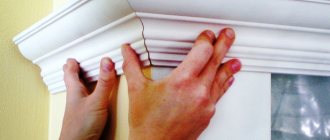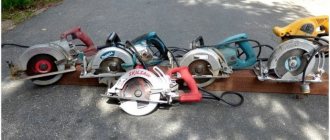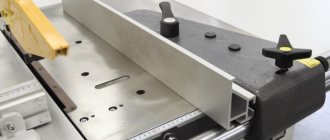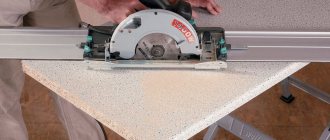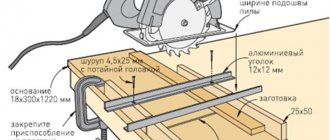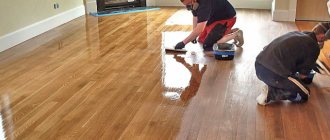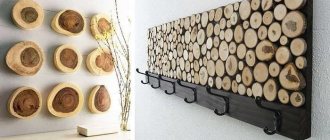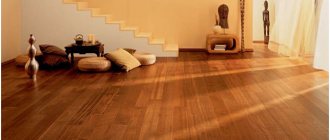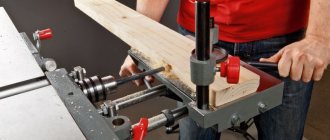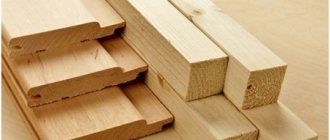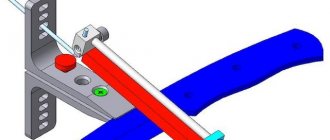Video: How to Cut with a Circular Saw at 45 Degrees
When purchasing, be sure to pay attention to such an indicator as the depth of the saw
Note. The cutting depth of the saw blade ranges from 30 to 130 mm.
You need to know what thick boards you need to work with. The choice of saw is also very important. For a neat cut, a disc with a large number of teeth is suitable. If the disc has sparse teeth, the cut will be faster, but the cut will be rougher.
Sections with such a saw are usually smooth and practically free of chips
How to make a 45 degree cut?
This angle is found in the manufacture of various products. Let's start cutting. First, the saw blade moves ninety degrees. Depending on the model, there is a red bolt on the side that needs to be unscrewed.
The soleplate is then rotated to a 45 degree angle and secures the bolt back. Take a piece of chipboard as a blank. We secure it with clamps to the table top so that the part is cut out of the table.
After setting the line. It is usually included with the circular saw. The saws have 2 marks zero and 45. We will cut 30 millimeters, for which we combine three on a line with a mark of forty-five on the sole. Then tighten the screw that secures the ruler.
Next, the sole should be positioned so that the ruler rests on the edge of the workpiece. The saw starts and, after it is completely unwound, presses the ruler firmly against the edge of the workpiece and moves forward.
Seeing advice
If you cut the edges with a chip, you should do the following:
- Take a small sheet of 6 mm fiberboard.
- Glue this sheet to the base using adhesive tape.
- With the saw running, we plunge the blade into the rigid board to create a recess with zero clearance.
Accurate cutting pattern
How to make a cut? The device was made with a slight fit, after pressing the circular stop we sawed off the edge of the base to the desired length. The saw blade defines the cutting line for the circular saw.
The board is marked instead of a saw. Pressed with a lower accent to match the board, the edge is aligned. By having the saw go through the device first, cutting boards are more precise.
Make a straight cut using a circular saw
To create a guide, we take a piece of plywood from twenty-five to thirty centimeters wide. It must be secured along the intended cutting line.
If you need to cut long materials, it will take a lot of time to measure and set the straight guide on the marking. To simplify this process, you can make a template yourself, for example, from fiberboard. The edge of the template is aligned with a mark on the workpiece and there is a straight guide attached to the back that needs to be secured with a clamp.
You can even use a similar pattern to use a jigsaw or router bit.
Angle check
When installing a miter gauge on a circular saw bench, you should not rely entirely on the degree scale: often cast or stamped marks are inaccurate, as confirmed by checking with a regular drafting square.
Periodically check the position of the saw blade itself in relation to the table surface - especially after miter cutting. To do this, set the disc to the maximum cutting depth and attach a square to the disc. This will allow you to quickly identify whether any set screw has become loose due to vibration from the running engine.
Place the square on the saw blade and you will immediately see whether it is at right angles to the table surface.
How to cut a board at a 45 degree angle
Place the square on the plane of the saw blade and check that the miter gauge is installed strictly perpendicular to the blade.
Important features when choosing the right blade.
If you are a beginner and don't have the services of a circular saw expert, choosing the right blade can be a little daunting. There are different types of saw blades designed for different materials, types of cutting, and for different power saws. Then one of the most important characteristics when choosing is the diameter and type of blade. You just have to make sure that it is compatible with your circular saw model.
Here's a quick guide to help you find the right sheet:
- Hand saws accept smaller diameter blades, typically 4 to 7 inches;
- the saw will require a diamond blade with a diameter of 7-10 inches;
- table saws require 10 or 12 inches, and table saw blades must have a carbide tip;
- For cutting metal, 14-inch blades are typically used.
Another important feature is the RPM (or revolutions per minute). For example, smaller sheets have higher rotations and larger sheets have lower rotations. The recommended saw speed should be lower than the recommended blade speed
Please note that a saw's RPM does not directly indicate its cutting speed, so higher RPM does not mean it will cut faster
The diameter of the blade will affect the speed because the edge of the larger blade will move faster compared to the edge of the smaller blade as it covers more distance at the same time. On the other hand, don't rush to select a larger blade, as you also have to consider the desired cutting quality. So when looking for a suitable RPM indicator, consider the material you will be working on.
To do this, you must calculate the SFM, which is equal to Surface Foot Per Minute. The formula is as follows:
SFM = (diameter / 12) * O * RPM
Typically, you will need an SFM of 5,000 to 8,000 for wood materials, and less than 1,000 for metals.
Also pay attention to the cut line indicator when selecting a tool. This is so you can see where your sheet is going as you cut.
Without this, you will have a harder time cutting a straight line. The cut indicator is usually located on the motherboard and looks like two small notches. However, in some cases you may not be able to see the crop indicator. For such cases, a small window that shows you where the leaf is is helpful, so look for it. Feel free to grab the tool and see if it feels comfortable.
Next, take a look at the motherboard. What material is it made of? Magnesium base plates are more stable, but can break if you drop the saw. On the other hand, an aluminum base plate can flex when you need it most, while plastic base plates are stable and impact-resistant.
Regardless of the material, the base plate must be flat in length and width and have a straight edge. At the end, take a look at the guard. Guards with sharp or rough edges can get stuck on wood surfaces during cutting and make lifting difficult.
When it comes to what you are going to cut, you should also pay attention to the type of blade. Different types of materials work better with different types of blades
For example, there are blades designed for cutting wood, plastic and acrylic, metal and several materials. Here are some types you may need:
- Rip Cut is wood cutting; Consequently, cutting blades are designed to cut along the grain: these blades have fewer teeth, specifically designed for aggressive cutting;
- The cross-cut blade is designed for cutting grain and has 40 to 80 teeth designed to provide a clean cut;
- Combination blades are used to make both crossed and ripped cuts as they have groups of teeth separated by a throat.
Since the teeth make a cut larger than the disc itself, its shape and quantity must be taken into account. This is another aspect of the blade that will affect your cutting performance. The more teeth, the more accurate the cut will be. Additionally, the shape of your teeth determines the quality of your cut. For example, the alternative top bevel type is suitable for quick cuts in rough wood that are along the grain. Multi-material blades are good for cross-section, and radial arm blades have a negative angle to avoid automatic feed.
Determining the slope of the roof - what it depends on
To correctly calculate the roof slope, it is necessary to take into account several factors, among which the following stand out the most:
- Wind loads. The slope of the slopes is greatly influenced by the wind. In order for the roof to be able to properly resist its influence, you need to choose the right angle. If the angles are too large, the load on them will be high, but an excessive decrease in the angle can also be dangerous - a flat roof can simply be torn off by a strong gust of wind.
- Snow and rain loads. With snow, everything is quite simple - increasing the angle of inclination simplifies its descent from the roof surface. When the roof is tilted more than 45 degrees, snow will hardly linger on it. The situation is the same with rainfall - if the angle of the roof is too low, then water can flow into the joints or even stagnate on the roof surface.
Based on these factors, you can calculate the angle of inclination of the slopes
In addition, before calculating the angle of a gable roof, you should pay attention to the recommended indicators: for areas with strong winds, a slope of 15-20 degrees is suitable, and in other cases, the optimal slope is 35-40 degrees. Of course, you need to understand that the roof is calculated individually in each case, and choosing average indicators is simply undesirable
Tools used
There are several ways to cut a pipe; for this, construction and industrial tools for metal processing are used. Of all the types, only the grinder allows you to obtain curved surfaces without further processing with the closest arrangement of edges.
For individual use
The following tool is used for cutting steel pipes at home:
Manual pipe cutters. Allows you to cut round parts with an even, right angle of cut due to the cutting edges of the rollers. There are several varieties of products of this type, consisting of single rollers or a series of rollers attached to a chain. In everyday life, such devices are quite rare and are more suitable for professional work.
Bulgarian. It is a universal tool for cutting any metal parts with different angles; special metal discs are used for the work, which are ground down quite quickly during operation. This allows you to accurately cut a curved line with a small diameter disc.
Rice. 7 Customized pipe cutting tool
Gas-burner. A quick and effective method of cutting metal surfaces with a hot jet of flame; the disadvantages include melted edges, which complicate further welding. It is difficult to use a gas torch to cut a product according to a paper template, which will burn, and if a line is drawn, then it will practically not be visible in the stream of flame.
Electric pipe cutters. To work with pipelines of small diameters, you can use compact electric pipe cutters, whose operating principle is similar to a grinder. The device is called a roller machine; during operation, the part is mounted on a bed and rotated on roller guides; its surface is cut from above by an electrical device. The main difference between a pipe cutter is the metal disc, which has a special durable coating for cutting metal.
For industrial use
In industry, large-diameter pipelines are used to transport liquids and gases, so pipe cutting units are heavy and have large dimensions. There are also manual pipe cutters of the rotary and clamp operating principle. In the first case, the cutting rollers rotate along a round surface using an adjustable handle; in the second version, cutting is carried out by arcuate plates, which gradually move during rotation.
Rice. 8 Industrial pipe cutting equipment
How to protect your saw from damage
Any saw (especially its cutting edge) should not come into contact with other tools during storage. Such proximity can quickly cause it to fail.
If the saw does not have a cover, then a simple method will help protect its teeth from damage. A slot of the required length is made in a piece of hose, after which the hose is placed on the saw blade. A rigid hose covered with fabric on the inside is best suited for this purpose. It holds tightly to the saw blade even after repeated use.
READ Adjusting the carburetor of the Champion 254 chainsaw
If longitudinal sawing is carried out in large volumes, then it is better to purchase a circular saw. Doing this with a handsaw will get you dirty. This is the first, and second: the information that can be gleaned from the texts in the frame is incomprehensible for a beginner, and useless for a professional.
Technology for cutting pipes at right angles
If we exclude the options used in industry - dies with mandrels, devices for radial cutting - then there are not many solutions available to the home craftsman. In any case, you will need either a hacksaw or a hand grinder. The adjustment is facilitated by the fact that the tubular product always has only linear contact with the cutting plane.
How to saw off a metal pipe smoothly? It is enough to firmly clamp the metal workpiece with parallel clamps, mark the cutting area with a marker and cut it to size. Of course, within the gaps between the hacksaw blade and the mounting bases of the hacksaw, play is always possible, resulting in a burr on the joint surface. If subsequently the inclined section of such a joint is joined to another element of the pipeline using manual arc welding, then this is not a problem: everything can be corrected (within reasonable limits) by changing the thickness of the weld. Otherwise, you should simply select a new tool and constantly monitor the marker markings during the cutting process.
It’s even easier to cut the end using a pipe cutter (it’s inexpensive, in extreme cases you can borrow it from a more skilled neighbor). This tool is equipped with a special screw-type feeding device. The sequence of actions using a single-roller pipe cutter is as follows:
- The surface of the workpiece is thoroughly cleaned of traces of dirt, grease or scale.
- The divided area is tightly compressed with jaws (if the pipe is made of soft metal, for example, aluminum, it is better to place a rubber corrugated plate between the jaws: the clamping friction will increase).
- By rotating the feed screw, the cutting roller is gradually inserted into the wall until the roller cuts through it.
- Change the position of the round pipe, rotating it 1200 so that the cutting roller comes into contact with the new cut section, and repeat the transition.
- We perform one more reinstallation - and the straight section of pipe is ready. All that remains is to clean the areas of the overlap.
There are three- and four-roller pipe cutters, where the cutting process is quite simple, since the number of reinstallations is correspondingly reduced.
How to cut steel pipe at 45 or 90 degree angle? First, you should check whether the pipe cutter you already have is suitable for sawing a particular part. The following are taken into account:
- Strength limit of the material;
- Diameter or wall thickness;
- The condition of the cutting edges of the roller/rollers and the gaps in their axes.
Note: In especially critical cases, you should first practice on an unnecessary piece of pipe.
How to cut thin-walled pipes
The clarification is essential if a power tool is used
For thin-walled pipes, it is important to maintain a clean cut throughout the entire wall thickness
When using thin cutting discs, remember that they generate less heat during operation, create less tool vibration, cut in less time and waste less metal per cut.
Sequencing:
- Clamp the workpiece securely near the intended cutting point and ensure that the workpiece does not move.
- Using a template, check the correct installation of the tool and the fastening of the disc by running the grinder idle. This is necessary in order to eliminate possible problems with balancing the circle.
- When starting to separate the workpiece, the disc is always fed at a 90° angle to the workpiece, ensuring that the protective guard is positioned between the worker and the workpiece. During cutting, it is necessary to avoid hitting the disc with the metal, for which the process begins from the area where the metal is thinnest.
Important! When working with thin-walled parts, do not apply too much pressure; the disc will do its job well.
Advantages of tile end sharpening technology
The development of sharpening the ends at 45 degrees eliminates the need to use decorative corners when finishing external corners. Thanks to this, it will be possible to make the wall look neat. Such corners have a more discreet and elegant appearance than those trimmed with corners. Agree, this is much more exciting than tiles laid on tiles or plastic inserted.
Electric tile cutter
A tile cutter is a machine for cutting tiles at 45 degrees, also for cutting them longitudinally and transversely. This device has a water cooling system. In addition, water helps to remove virtually all the dust that occurs during the cutting of porcelain stoneware or clay tiles. The main advantage of a tile cutter is its accuracy. He cuts one at a time, following a previously given line of movement. This allows you to eliminate the influence of reasons such as trembling of the master’s hands. In the end, the cut comes out very even and careful.
Tile cutters can cut at almost any angle. True, craftsmen often cut tiles at an angle of 90 degrees or 45 degrees.
Types of working attachments
When sawing logs with a chainsaw, various attachments are used.
- Attachment for longitudinal sawing. Used for sawing logs lengthwise , the process takes place in a horizontal position. After work, the master receives the same thickness of the product. The finished materials undergo a drying process, after which the boards are used in construction. In appearance, the device is a small frame; it is attached to the tire on each side.
- Drum debarker (debarker). With the help of such an attachment it is easy to dissolve the log; it works due to a V-belt drive. Attached to belts on both sides, special pulleys are used for this. The speed of rotation of the shaft depends on the size of the pulleys, so the performance of the attachment is easy to change. This technology forces the master to carefully monitor each stage of the process; some specialists use an assistant during this cutting. But this option requires increased security measures.
- Sawing with a lightweight nozzle. The method is not very productive, but is used quite often. The element is fastened on one side, but the workpieces are slightly uneven. Such materials are necessary for the construction of sheds or fences.
READ How to cut a board straight lengthwise with a jigsaw
90 degree cutting
To cut a round pipeline or metal profile of rectangular cross-section evenly across, use a sheet of plain paper. They wrap the workpiece so that the edges of the paper sheet coincide, after which it is fixed to the part using tape or glue. Using a grinder, a thin line is drawn near the edge of the paper sheet, after which it is gradually deepened until it is completely cut out.
Collar insert
To obtain branches of metal pipeline lines in the form of tees, a collar insert is used, for which it is necessary to cut the edge of a round pipe adjacent to the walls of another at a right angle. To implement the method proceed as follows:
- cut the edges of the workpiece at right angles using the previously described method.
- On the round end surface, a marker marks four equidistant points located at angles of 90 and 180 degrees to each other.
- The size of the circle is measured, the resulting diameter is divided by 3. The resulting distance is plotted from two diametrically located points, after which these points are connected to two others by a smooth arc, drawing a line with a marker.
Fig.5 Example of a collar section of a pipe
According to the markings, a cut is made with a grinder and semicircular segments are separated, after which the part is ready for welding. If there are minor inaccuracies in the mating, it can be compacted with a sledgehammer, placing it against the round surface of another element.
Homemade attachments
Masters have long learned to do a lot of things with their own hands. There is a huge variety of frame designs on the Internet that allow a chainsaw to cut logs into boards. There are simple manual options, there are large complexes of a frame and guides, with the help of which the tool moves or the log rises/lowers. One of them is in the video below:
How to evenly saw off a block, board, plinth, cashing.
Please note that the structure is assembled from metal profiles, which makes it reliable and stable. At the same time, the machine (it simply cannot be called otherwise) is equipped with mechanical gearboxes that simplify the process of moving the workpiece barrel and the chainsaw. No manual effort, just turn the handle from the gearbox. In this case, the thickness of the boards is adjusted by lifting the log, and not with a gasoline tool.
Another option is an attachment that helps make cuts not in a horizontal plane, but in a vertical one. The design is simple, but it is more difficult to work with because you have to make an effort to hold the chainsaw. In addition to the device, you have to prepare a metal strip or board, which is attached to the log in the longitudinal direction. It is on this that the frame-nozzle rests when cutting is carried out.
In addition, this option is more dangerous, because nothing holds the board being cut. She may hit her leg if she falls. So the process needs to be carried out carefully. The video below clearly shows how this option works.
Another setup that the manufacturer called a carriage. For this purpose, such a frame structure was made from a profile pipe and several wheels, which will give the device some mobility in terms of moving along the workpiece barrel. They are also a kind of stops that do not allow the chainsaw to move from side to side.
In addition to the carriage, a regular aluminum ladder is used, which acts as a guide element. It is attached to the log with clamps on nails or screws.
Please note that the width of the ladder must match the distance between the carriage wheels located at its different ends. The staircase must be placed in a horizontal plane using a building level. It is leveled by placing pieces of boards of different thicknesses underneath it.
The prepared chainsaw with the carriage is installed on the stairs. Turn on the engine and push along the workpiece with your hands, cutting off its upper part.
From the side the process is visible better. Here you can see a carriage with wheels, a ladder, a log lying under it, and how the cutting process is carried out.
The design of this type of device is quite complex. But of the many homemade manual options, it is better, more convenient, and more reliable. It became possible to adjust the cutting height horizontally by first installing a ladder along the horizon.
Composition and features of the material
To understand how to properly cut a plinth, you need to understand its composition. This will help you choose the right tool and cutting technology.
- Styrofoam. The price and strength of this material are the lowest. But since we are creating a decorative decoration for the ceiling, strength is not particularly required.
- Ceiling plinth made of polystyrene foam is more dense. than regular foam. To cut such material, the most ordinary knife is used.
Tip: sharpen the knife well before use. This will eliminate the presence of torn edges at the incision sites.
How to cut a skirting board straight
Tree. Here you will have to put more effort into processing. For wood, use only a hacksaw.
How to use a hand saw
The saw needs to be driven, otherwise it will start “walking”. This must be taken literally. Wood is a living material, and its behavior is unpredictable. Hard growth rings, knots, cracks, high humidity and high resin levels can seriously complicate sawing.
For this reason, there is no universal tool that can take into account all the vagaries of wood, but there are many different special saws. The shape and order of alternation of their teeth are determined not by the material from which the saw blade is made, but by its purpose. Some tools can only be cut in a straight line, while others, on the contrary, are better able to cut in a circle.
When sawing, only the saw moves; the workpiece must be securely fastened. Therefore, you will need stable support. For example, a workbench or sawhorses. The workpiece is secured with a clamp or held by hand, and especially large ones - additionally with a knee.
Sawing begins and ends with repeated light pulling of the saw in the opposite direction, that is, a “trace” is laid. At the end of sawing, you must hold the remainder firmly so that it does not break off along with the piece of main wood.
Sawing is one of the most common processes in wood processing. A clean, even cut is not a problem if you choose the right tool and know how to use it.
In the photo (from top to bottom): large and small hacksaws; saw with a “back”; saw with a narrow blade. Next to the left is a saw for finishing cutting.
What is a miter box for?
A miter box is a hand-held carpentry tool for precise cutting of boards and other lumber at the required angle. When making a wooden frame, installing platbands and baseboards, or performing any other work related to cutting boards, you will definitely be faced with the need to create a perfect corner cut - the so-called miter joint. In order for the joints of the parts to fit tightly and have no gaps, the cutting angle must be as accurate as possible. Here a miter box becomes an ideal assistant.
There are several design options for this device. In our article we will dwell in detail on the main types of miter boxes, tell you how to choose and correctly use this hand tool to create a flawless burr.
Lining for part
Sawing the part laid on the lining. Since the width of the cut in the backing is equal to the thickness of the saw blade, you can saw off a strip just a few millimeters thick from the part without fear of injury. Of course, the backing plate device can be used many times, so keep it just in case. It is very important to position the pad correctly on the table, otherwise the cut will become wider each time.
A plywood plate prevents thin scraps from getting into the gap between the saw blade and the work table.
Methods for cutting metal products at an angle
Conventional perpendicular cutting at 90°, using a grinder, is carried out quickly and efficiently, if you do not neglect the advice of specialists.
Many people believe that if a large tool with a large powerful disk is used for sawing, then there is no need to apply markings. Experts do not recommend sawing without marking, because after cutting the parts may not align.
Features of cutting a cylindrical pipe at 45
Most often, making a cut at an angle of 45 degrees is required when installing heating or plumbing systems. The main difficulty in carrying out the work is that after combining the cut parts of the pipe, a right angle of 90 degrees should be obtained. A simple way to prepare a homemade pattern will help you achieve the quality of the cutting process:
- Prepare a plain white sheet of paper.
- Fold it diagonally.
- The protruding part of the sheet must be cut off with scissors so that when unfolded you get a square.
- The resulting triangle must be wrapped around the pipe so that the long side runs parallel to the section.
A paper template is great for cutting metal products in the middle.
Paper template
The resulting triangle, folded in half, must be divided into two parts. Then the templates need to be wrapped around the pipe and secured with tape or tape. The templates should be positioned so that one edge of the base coincides with the second.
Use scissors to round the top corners of both templates. The resulting two blanks of the required diameter should be placed on the pipe, and the cut location should be marked with chalk or a pencil. The prepared marked part can be safely sawed off.
For small diameter tubes that need to be cut close to the edge, the marking method using a container of water is suitable. The desired angle of inclination of the cut is marked on a deep container, then the end of the tube is placed in the water and tilted towards the marking. The line of contact with the liquid will become a cutting mark.
How to mark a 45mm cut on a profile pipe
Not everyone knows how to cut a profile pipe at 45 degrees with a grinder correctly and efficiently. Experts advise using an ordinary triangular ruler to mark a profile pipe with a square cross-section.
First, a straight strip should be drawn on one of the faces, located perpendicular to the side of the pipe. Then the workpiece must be rotated and an oblique mark applied to the adjacent face. It should go from the edge of the first strip at an angle of 45 degrees.
After this, the product is turned again and a perpendicular line is drawn. On the fourth side, all that remains is to connect the previously drawn stripes diagonally. Now you can start cutting.
Teeth and their shape
The capabilities of the saw depend on its shape and size of the teeth. A large number of teeth on a given length of blade means a fine cut but slow forward progress. A small number of teeth produces a rough cut.
Wood is made up of fibres, and when sawed they separate. This creates sawdust that needs to be removed. The finer the teeth, the faster the cut and the cutting edge of the saw become clogged with small sawdust - saw flour. The teeth can no longer grip wood to its full height. Sawing is becoming more and more tedious and, most importantly, unproductive. But large teeth almost never get clogged due to the greater distance between their tips and each other.
Almost any saw has teeth that are set apart, that is, their tips alternately deviate to the left and then to the right. The greater the angle of inclination, the wider the cut strip, and therefore it becomes less clogged with sawdust, and the saw jams less.
Over time, saw teeth become dull and need to be sharpened. In this case, the damaged wiring must be restored. Even for a specialist this is not an easy job. Therefore, we recommend purchasing saws with hardened teeth. They don't get dull as quickly, and they are easier to sharpen than the teeth of a regular saw.
You just need to put the saw blade on the table and use a sharpening stone to run it twice along the cutting edge from the end to the handle, then turn the blade over. The saw is sharpened, you can start working.
The design and principle of operation of a circular saw
The main parts of a hand-held circular saw include:
- Electric motor. With its help, rotational energy is created, which is needed for cutting the material.
- Frame. For its manufacture, plastic is used that is resistant to temperatures and shocks. It has holes for ventilation.
- Handle with start button. The latter is equipped with a lock designed to prevent accidental pressing.
- A platform with a guide (it is also called a sole or base plate). Thanks to this element, the tool is moved along the workpiece being cut.
- Spindle for fixing replaceable disks.
- Gearbox. It is designed to reduce the speed, load on the rotor and bearings of the electric motor.
- Main and additional handles.
The principle of operation of the equipment is to transmit torque from the motor shaft to the cutting disc. The latter rotates around its axis at high speed, this makes it easy to saw the prepared surface.
Circular saw device
Auxiliary bars
When working with a circular saw, as when driving nails, you must follow the rule: if possible, keep your fingers away from the danger zone! So, it is better to hold small nails with pliers rather than with your fingers. And even more so, you should not bring small parts to the saw blade with your hands: it is better to advance the part with special gripping bars.
Some manufacturers include feeder bars as part of the accessory kit included with their table saws. But such bars are easy to make yourself. To do this, you will need two bars from 30 to 50 cm long with a cutout at one end. The bars are placed with cutouts to the edges of the part - as shown in the photo at the top left. With one bar they move the part towards the saw blade, with the other they press it from the side against the parallel stop, thereby preventing the part from moving to the side.
Similar assistance when sawing thin boards or plywood boards can be provided by another device - a piece of board or blockboard 20-30 cm long, on the longitudinal edge of which there is a protrusion about 5 mm high. This segment is placed with a protrusion on the rear edge of the part and with its help the part is advanced, while simultaneously moving the sawn part away from the sawing disk.
emphasis on the circular to the left of the disk
It is better to fix the position of the part during the sawing process with two bars: one moves the part, the other presses it from the side to the guide.
A section of board with a lip helps guide the thin plywood board during the sawing process. The device must be installed on a narrow, sawn-off part of the part.
What can you do with electric circular saws?
Electric circular saws allow you to process wood and wood-based products in different ways, which depend on the type of tool chosen.
Types of work with a hand-held circular saw
The following types of work can be performed with a hand-held circular saw:
trim multiple workpieces laid in one plane;
trim wide boards using a rip fence that cannot be cut on a pendulum saw;
trim boards when laying floors;
trim the workpiece at an angle, without a guide and with its use;
perform longitudinal sawing of the workpiece at an angle;
align the unedged board along a pre-drawn line;
choose a quarter in a board or timber;
cut sheet materials using a guide rail;
By changing the equipment, you can use a circular saw to cut metal profiled sheets;
cut plexiglass and various types of plastic;
Place the hand saw in the table and use it as a stationary circular saw.
Working on a circular saw
Working with a circular saw (stationary) is slightly different from working with a hand-held unit. Using a circular saw you can do the following:
cut and trim wide workpieces, both with a straight cut and at an angle;
perform longitudinal and transverse sawing of wooden panels;
cutting wood-based sheet materials;
open the board at an angle;
sawing an unedged board.
Types of work with a miter saw
You can do the following with a miter saw:
trim wood blanks at any angle relative to the edge;
trim the workpiece at an angle to its face;
a miter saw with a broach allows you to cut wider workpieces;
Edge cuts
If you need to form a large board from several boards, then round insert tenons or dowels in the form of narrow strips of plywood are used to fasten them together. Holes are drilled for tenons, and grooves are cut for dowels.
To cut a groove with a circular saw, the board is placed on its edge and in this position is brought to the saw, but this requires a reliable guide (if you hold the board with your hands, it is unlikely that you will get an accurate cut).
It is often enough to connect the workpiece to a wider board with two clamps or twings and thereby provide the workpiece with reliable support.
Boards in a stack
Still, it is better to use at least two or three boards (or strips of wood board) for support. This tsulaga (backing boards) is connected flush along the longitudinal edge and clamped to the workpiece so that it is fixed on the edge exactly at right angles to the table surface. If you need to cut grooves in the side edges of several boards, then these boards themselves can be used alternately as tsulagi. When replacing boards, you need to use a square with shelves to check whether the “package” assembled from boards is perpendicular to the plane of the desktop. The workpiece with the tulaga is moved along a precisely set parallel stop so that the groove being cut is straight.
Several boards clamped with a clamp support the part, providing it with a stable position when processed with a circular saw.
JBTS-10 Table Saw Manufacturer Details
The supplier of the JBTS-10 table saw is JPW Tools AG Switzerland, which is a subsidiary of Walter Meier (Tool) AG. Website address: www.jettools.com
In Russia, Jet products are exclusively represented by ITA-SPb, St. Petersburg, founded in 2004, as a subsidiary endowed with all rights for sales, promotion and technical service.
Machines manufactured by JPW Tools AG, Switzerland, China
- JBTS-10
– circular table saw - JKM-300
– combined woodworking machine - JPS-10ts
– stationary circular saw - JPT-10B
— tabletop jointing-thicknessing machine - JPT-310
– stationary planer-thicknesser machine - JRT-2
– milling table - JTS-315sp
– construction circular saw - JWP-12
- table thickness planer - PKM-300
– combined woodworking machine - BD-3
- table lathe Ø 100 - BD-7
– table-top screw-cutting lathe Ø 180 - BD-8
– table-top screw-cutting lathe Ø 210 - BD-920w
– table lathe Ø 220
An example of calculating the roof slope in degrees
To understand how to calculate the angle of a roof, it is worth considering the calculation process using a specific example. For example, the following data will be taken: the lathing has a thickness of 2.5 cm, one square meter of roofing weighs 15 kg, insulation with a thickness of 10 cm is used as a thermal insulation material, a square meter of which weighs 10 kg, and ondulin with a weight of 3 kg is used for the covering. per square meter.
The calculation of the roof slope is carried out in accordance with the method described above. Substitution of the available data leads to the following expression: (15103)x1.1 = 30.8 kg/sq.m. The obtained value is quite acceptable - the average load on the roof of residential buildings is slightly less than 50 kg/sq.m. In addition, the formula contains a coefficient of 1.1, which slightly increases the actual weight of the roofing structure and makes it possible to subsequently replace the roofing covering with a heavier one.
Sources:
https://www.remontiruemlegko.ru/kak-rabotat-ruchnoj-piloj.html https://sinstrument.ru/brus/kak-raspilit-brus-vdol-svoimi-rukami.html https://morflot.su/ otpilit-pod-uglom-45/
How to use a miter box correctly
Using a miter box greatly simplifies the work of the master. Next, let's look at what a miter box is used for using specific examples. Before work, carefully read the instructions from the manufacturer.
How to cut material
To properly cut an element, you need to carefully prepare the material by taking a miter box with a saw. The presence of grooves allows you to make accurate and even workpieces since the saw will take the set position. The first step is to secure the tool with screws or a clamp on a flat surface. Next, use a pencil or laser to make a mini-drawing. The workpiece is placed in the tray. In this case, the marking should be opposite the corresponding slot. Then a hacksaw is inserted and the cut is made.
All kinds of useful stops
For a long time, home craftsmen have been using homemade stops to simultaneously saw several workpieces if they need to get parts of the same length. Instead of marking each piece, they are placed together against a fence and secured in the desired position relative to the saw blade.
The stops also help effectively when working with a table saw. However, they are installed only if the specified length of the part is shorter than the distance from the saw blade to the side edges of the table.
If you need to cut the workpiece into several short equal parts, then the stop is fixed either on a parallel guide or on an angular stop. The stop on the parallel guide is placed in front of the saw blade. The distance between it and the stop must be sufficient so that the sawn part of the workpiece does not get jammed between the disk and the parallel guide.
If necessary, the stop can be installed outside the desktop. To do this, a bar is attached to its side, thus lengthening the table, and a stop is attached to the free section of the bar.
If it is necessary to make a cut of a certain length in a part, then a clamp is attached to the parallel stop, into which the part will rest when the required length of the cut is reached.
If you need to cut the workpiece into several small parts of equal length, then it is not necessary to make preliminary markings: it is enough to secure the stop on a parallel guide at the required distance from the saw blade. The stop must be installed in front of the disc, not next to it!
The counter support can be mounted on the miter gauge and even, if necessary, installed outside the table. To do this, you will need a fairly long bar, which is first secured to the angle stop and then to the bar itself - a counter support.
The stop installed on the parallel guide limits the length of the cut. To do this, you only need one clamp.
How to cut correctly?
Let's consider step by step how to correctly and evenly cut an aluminum profile.
- First you need to apply markings to the metal workpiece. To do this, you can use a ruler or tape measure. Markers should be placed with a marker.
- A perpendicular mark must be applied to the product. It is along this that the side planes will be trimmed.
- Then folds are made along the marking line. Lastly, cut along the fold.
- If we are talking about cutting a rack profile, then the master needs to remember that it has auxiliary stiffeners. Sometimes they come out slightly uneven. You can trim them with scissors. Slats with a length of up to 1 m can be cut by weight, but longer parts will require fixation in supports or a vice.
- To prepare lintels or small structures, the profile should be cut at an angle of 45 degrees. First you need to saw off the slats to the required length, after which you should mark the angle of the cut and complete the procedure by cutting it.
Profile cutting must be carried out strictly according to technology
When working with any tool, it is very important not to forget about compliance with safety regulations. It is better to stock up on all the necessary personal protective equipment, and carry out the work itself carefully, without rushing
You can see how to properly cut an aluminum profile in the video below.
Method of joining platbands without trimming
Today, platbands are often not cut at an angle and then joined together, but the joints are made at right angles. This method of connecting platbands does not require any special trimming, which is very convenient. In addition, this method looks more modern and attractive.
Cutting at an angle using a miter box
If you still need to cut this or that part at an angle, then you should stock up on a miter box - a simple device that looks like a small box. The miter box has slots that are designed for a saw or a long sharp knife. Of course, these slots are made to form a smooth and precise 45 degree angle.
However, a miter box can have many slots at once, at different angles. This is convenient because with the help of one device you can trim any parts at different angles.
There are adjustable miter boxes on sale. The slots in such a miter box can be adjusted, which allows the master to set exactly the angle that is required at the moment. In particular, it is quite simple to move the slits of such a miter box to a position of 45 degrees.
Now you can trim the workpiece simply. A baguette, platband or plinth is placed in the miter box, after which a saw is inserted into the slots and the excess is simply cut off. The angle ends up being perfect, exactly 45 degrees.
What to do if there is no miter box? Very simple. You need to make a template according to which it will not be difficult to transfer the necessary markings to the workpieces. As a template, you can choose thick cardboard or anything else that will be appropriate in this case.
How to properly cut a ceiling plinth at an angle of 45
Corner elements for ceiling plinths can be easily trimmed using a miter box or by hand. In the first case, you will need a miter box and a hacksaw, and in the second, a pencil and a hacksaw/cardboard knife. The hacksaw blade should be well sharpened so that you don’t have to think about how to cover up chips and roughness on the cut.
Cutting a corner using a miter box
We take a polyurethane ceiling plinth. designed for the left or right side of a corner. We lean it against the future installation location so that the end of the segment opposite from the corner is against the edge of the already glued molding. In the place where the bottom edge of the ceiling plinth touches the top of the wall corner, make a dot with a pencil or stick a piece of insulating tape. We repeat these steps with the second segment.
How to cut an external corner of a ceiling plinth:
- We place the left blank in the miter box from left to right, pressing it to the edge closest to us. The corner vertex mark should coincide with the leftmost slot in the same edge
- We place the right blank from right to left, pressing it to the near edge. The mark for the top of the corner is to the far right slot.
How to saw down a ceiling plinth at an internal corner? Everything is very simple, the actions will be exactly the same, only the location of the corner vertex mark changes. Here it’s the other way around: for the left segment – the far right slot, and for the right – the far left. The finished ceiling fillets must be aligned, and then the joints should be held up to the light - there should be no gaps. If they are very small, then editing is not necessary; you can get by with sealing with putty material after installation.
How to make a corner of a ceiling plinth: positioning the workpiece in a miter box
Important: sometimes the angles deviate too much from the standard 45 degrees, and a simple miter box for the ceiling plinth becomes useless - you can cut off the excess. The solution would be to purchase a rotary tool, but it is not cheap and this “one-time” purchase will be irrational. In this case, you can use the intersecting point method.
In this case, you can use the intersecting point method.
How to cut the corners of a ceiling plinth without a miter box
If you are wondering how to properly cut down a ceiling plinth without a miter box, then the following information will be useful to you. We take the right section of the ceiling plinth made of foam plastic, apply it to the installation site and draw a line on the ceiling along its upper edge. It should extend beyond the vertices of the corners by about 5 cm. We do the same with the left segment and put points at the intersections of the lines. We put the ceiling plinths in place one by one and transfer the resulting marks to them.
We've dealt with the upper part of the ceiling moldings, now let's move on to the lower part. Everything is simple here, the marks we need are the vertices of the corners. We mark their location with dots on the lower edges of the left and right ceiling plinth. Next, you need to connect the dots on the moldings - this will be the cutting line. This method will help you cope with even the crooked corners. Adjustment will most likely not be needed, and if it is, it will be minimal.
How to cut a ceiling plinth without a special tool: the photo shows marks for the intersecting point method
Important: the work described here requires marking the surfaces. Therefore, first you need to start cutting and fitting the ceiling plinth, and only then think about how to glue the wallpaper. Or, if you want to mount the plinth on top of the wallpaper, we do the marking and trimming before finishing, and gluing after it
Or, if you want to mount the plinth on top of the wallpaper, we do the marking and trimming before the final finishing, and the gluing after it.
Basic hand saws
Any home workshop should have at least three to four saws of different types.
- Hacksaw with a wide blade for rough cutting of large parts and workpieces. The longer the canvas, the faster the work goes. However, for the same reason, the mobility of the blade itself increases, which is why the saw, as they say, is pulled to the side. Therefore, it is important to carefully monitor the cutting line, preventing it from deviating from the markings. A new product in recent years is a Teflon coating on the hacksaw blade, which makes sawing fresh wood much easier and also protects the saw from rust.
- A saw with a “back” differs from a regular hacksaw not only in that it has a rigid attachment that “damps” vibrations of the blade, but also in smaller, closely spaced teeth. This saw allows you to make clean and thin cuts.
- The finishing saw provides an even and neat cut.
- A narrow blade saw is designed for cutting rounded parts and large holes. The basic rule for caring for any saw: its blade should always be dry and clean. Saw teeth - even hardened ones - should be sharpened regularly.
Narrowing the gap
It's not often that a DIYer has to cut very narrow strips of wood, as shown, for example, in the photo above. But if such a need arises, then care should be taken to ensure that thin cuttings do not fall into the gap between the work table and the saw blade, get stuck there, and then fly out at great speed, crossing the entire workshop.
The main thing in work is safety. For this, you can sacrifice a piece of plywood or hard fiber board. Saw the selected piece lengthwise, but not the entire length, place it on the table and attach it to the rear side edge of the table with clamps or using strips of adhesive tape on both sides.
Pressure spring
Anyone who frequently uses a circular saw can fully appreciate the usefulness and even the necessity of this device, which ensures absolute precision in processing - especially when sawing narrow boards and bars - while allowing you to keep your fingers at a safe distance from the saw blade. This spring presses the part against the rip fence without the risk of jamming it.
You can make such a spring yourself using the same circular saw. A wide plank of hard, fine-fiber wood, 40 to 50 cm long, is suitable as a workpiece. The plank is cut at one end at an angle of 45 degrees. Then several parallel cuts are made in the beveled end part. As a result, a kind of comb is formed. Although each of its teeth (about 5 mm thick) itself is quite soft and elastic, a comb of 15-20 such teeth provides a reliable elastic support.
Counter support
The pressing spring is secured with a clamp on the work table with a circular saw so that the beveled end edge is parallel to the saw blade. The second bar as a counter support is placed at right angles to the pressing spring. The bar securely holds the spring, preventing the part from moving. The presence of a pressure spring in no way precludes the use of a protective guard over the saw blade.
An oblique “comb” at the end of a wide bar presses the part against the parallel stop.
Cut line
Anyone who brings the part to the saw blade with the casing lowered cannot see whether the cut line coincides with the marking line. In this case, you should not give in to the desire to lift the guard and work with an open saw, without protection.
It is better to put a mark on the workbench that will clearly indicate the cutting line and help process the parts in accordance with the markings. To do this, stick a self-adhesive label on the table, use the miter gauge to slightly move the bar towards the rotating disk, and immediately pull the miter gauge back along with the bar. After this, it will no longer be difficult to transfer the cutting line from the plank to the label.
It is recommended that the mark be made in the form of a clear stroke exactly the same width as the gap in the table. This makes it possible to control the position of the part during the sawing process, and will also make it easier to install the rip fence at the required distance from the cutting disc with millimeter precision.
If the angle is not right
Unfortunately, in some cases the angle between the walls in a room is not straight, but acute, or, conversely, obtuse. This is due to design defects that arose due to the fault of unprofessional builders, the architect’s idea, or the result of soil subsidence some time after the construction of the building. This is especially common in village houses and cottages.
House plan with sharp and outer corners
No miter box or drawing replacing it will help in this case, and you will have to make markings in place.
- Place the workpiece against one of the walls so that its end rests against the other wall.
- Draw a line on the ceiling along the workpiece.
- Carry out the same operation against the other wall.
- At the intersection of the two lines, place a mark on the workpiece itself.
- Draw a line from the mark to the corner of the workpiece and cut along it.
- Do the same with the workpiece that you will attach to the other wall.
- Glue both blanks; they will fit tightly.
Read also: Steel 45 machinability
Suitable methods for this
There are many options for merging beams; they differ in methods, of which there are only 3:
- by cutting out a lock;
- using a wedge;
- using additional boards.
It is desirable that any of the listed methods include additional fastening with bolts, clamps, glue and other auxiliary elements. Otherwise, there is a risk of the bar moving.
How to dock with a lock?
This method is the most diverse of all, requiring precise calculations. From the joining ends of 2 beams, shaped locks are cut out with a chainsaw or using a hacksaw, which, when connected, grab each other, turning 2 small beams into 1 large one. The most common cutting methods are :
- half-tree butt;
- with end comb;
- frying pan;
- into an oblique overlay;
- oblique cut with tooth, etc.
Each of them has options. Somewhere several ridges or spikes are used, somewhere only one.
Sometimes the cuttings are combined, for example, a half-tree cut is made oblique. The principle of operation is always the same: on each beam, from the side of the joint, the cutting areas are marked out, and the excess is cut off. The connecting beam should have the same pattern, but in a mirrored form.
Build up with a wedge
The wedge method is most often done for miter cutting with an onlay . Two beams are cut according to the pattern, connected in the center and a beam is driven in the width corresponding to the width of the beam. This method is considered the most durable, but also the most difficult, since it is necessary to maintain high accuracy of calculations for 3 elements at once.
Connect with boards
In this case, locks are not cut into the beams and wedges are not driven in. They are held in place only by boards on 2 or 4 sides, which are bolted to the surface of the beams being connected. Aesthetics suffer in this case. But with this method, it remains possible to repair the joints and change the insulation. The bolts are secured in a staggered pattern using rubber washers.
In some cases, beams are simply placed one on top of the other and fastened with 4-6 bolts, without using any boards or cutting. Displacement at the junction is excluded in both cases. This method is suitable for small-caliber timber or boards .
